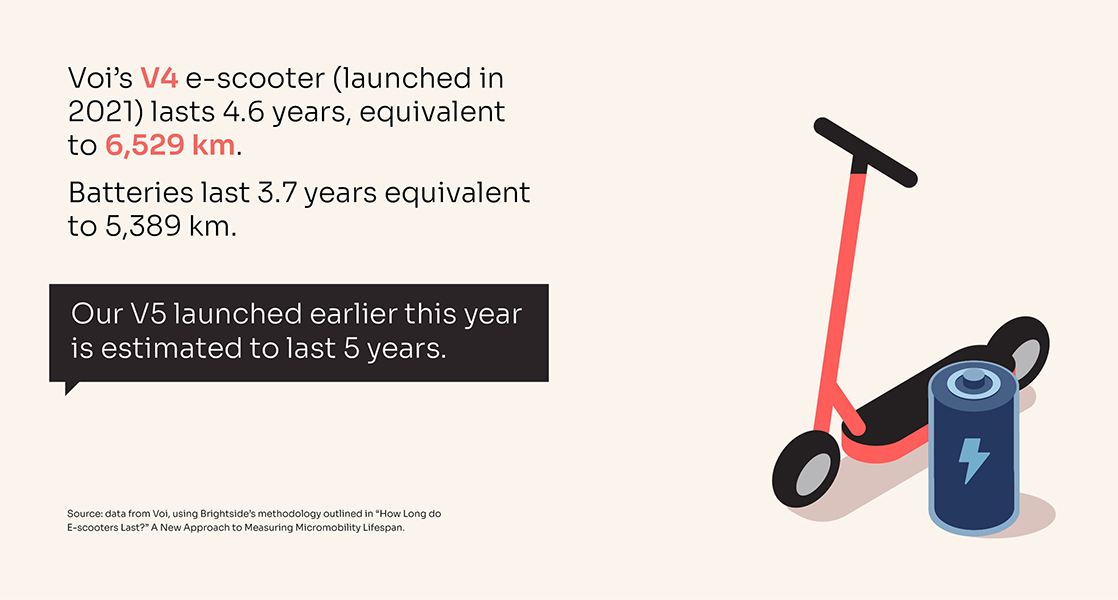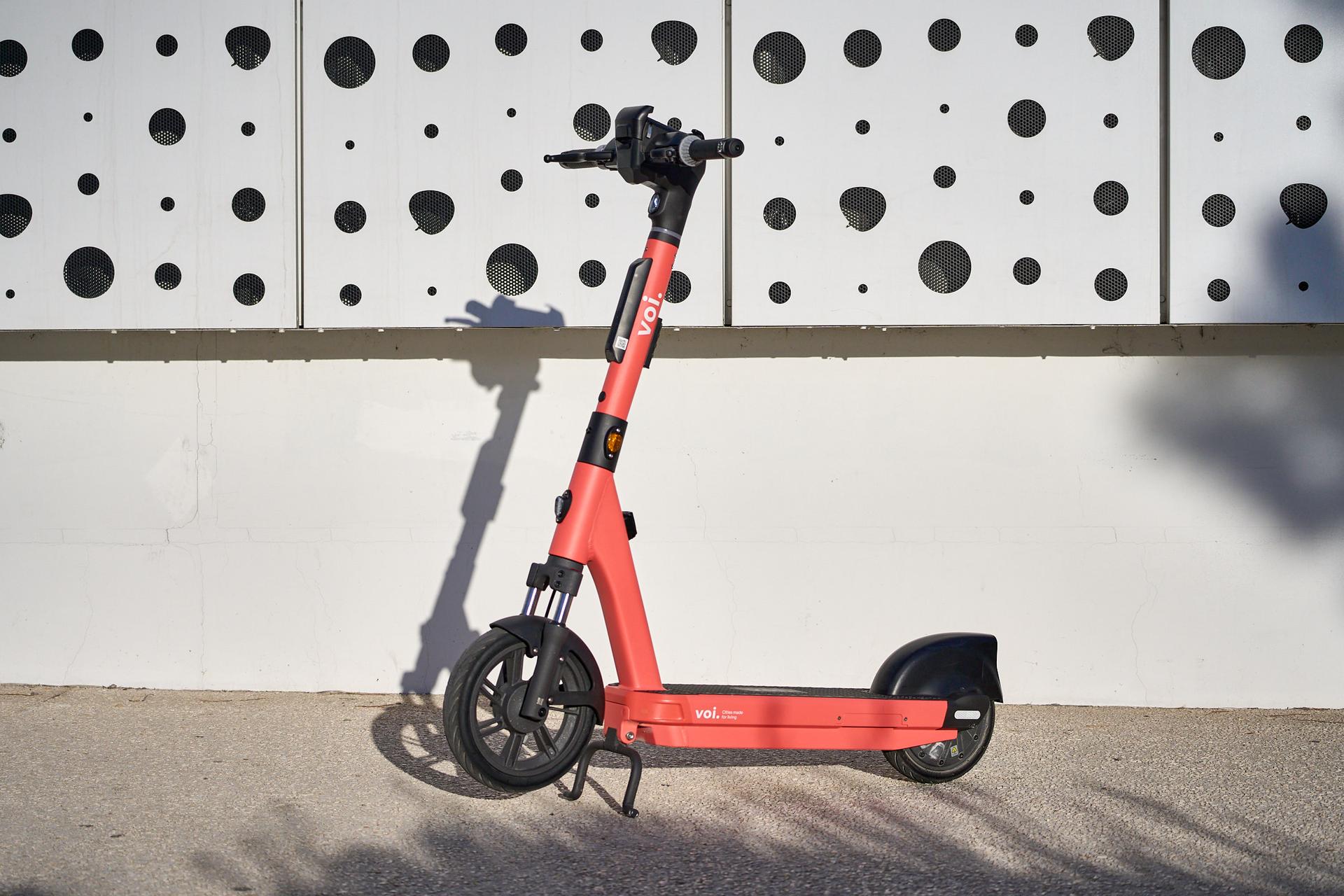Third-party report confirms that Voi’s electric scooters will last for many years to come
Nov 24, 2022

The lifespan of e-scooters has been a contested topic since 2019 when reports found that the shared vehicles only lasted a few months. But many improvements have been made to extend the vehicle lifespan, as outlined in a new – first of its kind – report from the mobility consulting firm Brightside.
Research shows that micromobility is a good option for up to 60% of urban journeys in European cities and could help cities curb car dependency and decarbonise transport. Despite this promise and the quick uptake of shared e-scooters, the sustainability benefits of these small vehicles have been questioned. A key concern has been the short vehicle lifespan reported in the early days of the industry.
Why is lifespan important?
While estimating the lifetime of cars, bikes or other vehicles that have been around for a long time, it’s not so straightforward to estimate how long vehicles that have only been around for a short time will last. Shared vehicles are also subject to more intensive use than private vehicles.
Vehicle lifespan is a key factor for micromobility sustainability. As e-scooters require energy and materials to produce, the longer their lifespan and the more rides they deliver, the better the carbon footprint per ride. Lifespan is a key input for lifecycle assessments (LCA) – the standard approach for determining the relative sustainability of transport modes.
“In the early days of the industry, a trip on shared electric micromobility was barely more sustainable than a car when total lifecycle was considered. This analysis confirms that taking meaningful steps to improve vehicle lifespan can improve this equation”, says Pierpaolo Cazzola, an independent consultant and lead author of the OECD’s International Transport Forum report Good to Go?.
A new methodology
With the new report How Long Do E-Scooters Last?, Brightside, a sustainable transport consultancy, is trying to set the records straight by proposing a standard to measure the lifespan of shared micro-vehicles. Brightside has analysed real-world data from Voi and consulted Pierpaolo Cazzola, and other noted experts in the field to develop a methodology to consistently measure how long shared e-scooters last.
How has the vehicle lifespan been extended?
The analysis finds that longer lifespans are largely attributable to improvements in vehicle design and circularity, including:
sturdier components, like a wider neck
modular parts, that can easily be repaired
proactive maintenance practices to ensure vehicles are maintained before they break down
improved GPS technology to reduce loss of vehicles
To continue improving sustainability in the industry, the authors recommend that Voi, and all e-scooter operators, collect more granular data on the lifespan of e-scooter frames and batteries and use this information to improve design and operations further. The authors recommend that all operators adopt this approach to calculating lifespan and be transparent in sharing this information with the cities in which they operate.
“I commend Voi for supporting this research and adopting a more transparent approach to data collection and reporting, and hope it will inspire other operators to follow suit”, says the lead author Melinda Hanson, founder of Brightside and a former head of sustainability at Bird.
So how long do Voi’s e-scooters last?
Using this methodology, the report estimates that Voi’s Voiager 4, the e-scooter model launched in 2021, has a lifespan of 4.6 years (6,529 km) for the frame and 3.7 years (103.4 kWh) for each battery. This is about 5 times longer than the vehicle models used when Voi launched in 2018. The Voiager 5, which Voi launched in March 2022, has an estimated lifespan of 5 years, based on the same model due to improvements in design and proactive maintenance.
Chris Cherry, a professor in sustainable transportation at the University of Tennessee who contributed to the report, says his research shows that electric micromobility is significantly more sustainable than most conventional forms of transportation and can replace car trips.
“While the shared electric scooter industry had some early missteps, I am convinced operators like Voi are on the right track, and hope that cities will take note and do more to support the continued expansion of small electric vehicles”, says Chris Cherry.
Recommendations for further improving sustainability
Pierpaolo Cazzola adds that further improvements are possible by optimising the way vehicles are repaired and integrating micromobility services with public transport, so that they have greater chances to displace trips that would otherwise occur by car.
In 2019, Voi was the first micromobility operator to perform and publish an independent lifecycle assessment (LCA), which has been instrumental in developing Voi’s sustainability strategy. So will this new vehicle lifespan report further improve the company’s sustainability performance.
”Voi has set ambitious environmental targets, and we’re improving our sustainability data collection. We are currently working toward a circular supply chain that will reduce waste by 50% by 2025. This report and methodology will help us to better understand and improve vehicle lifespan and be more transparent with our stakeholders”, says Sarah Badoux, Head of Sustainability at Voi.


